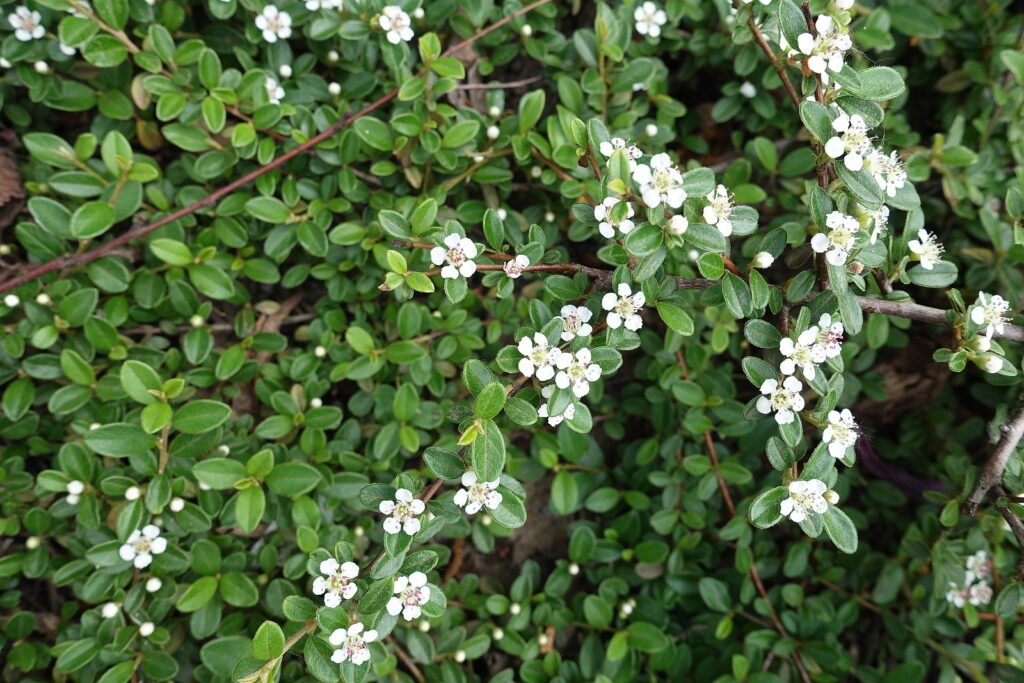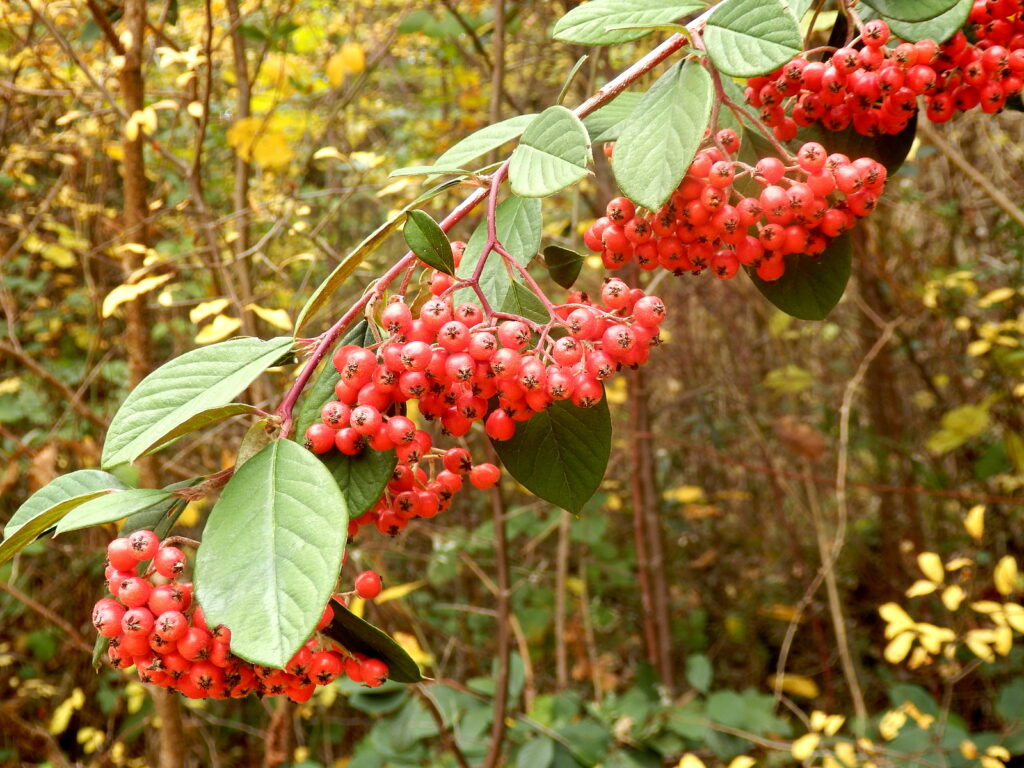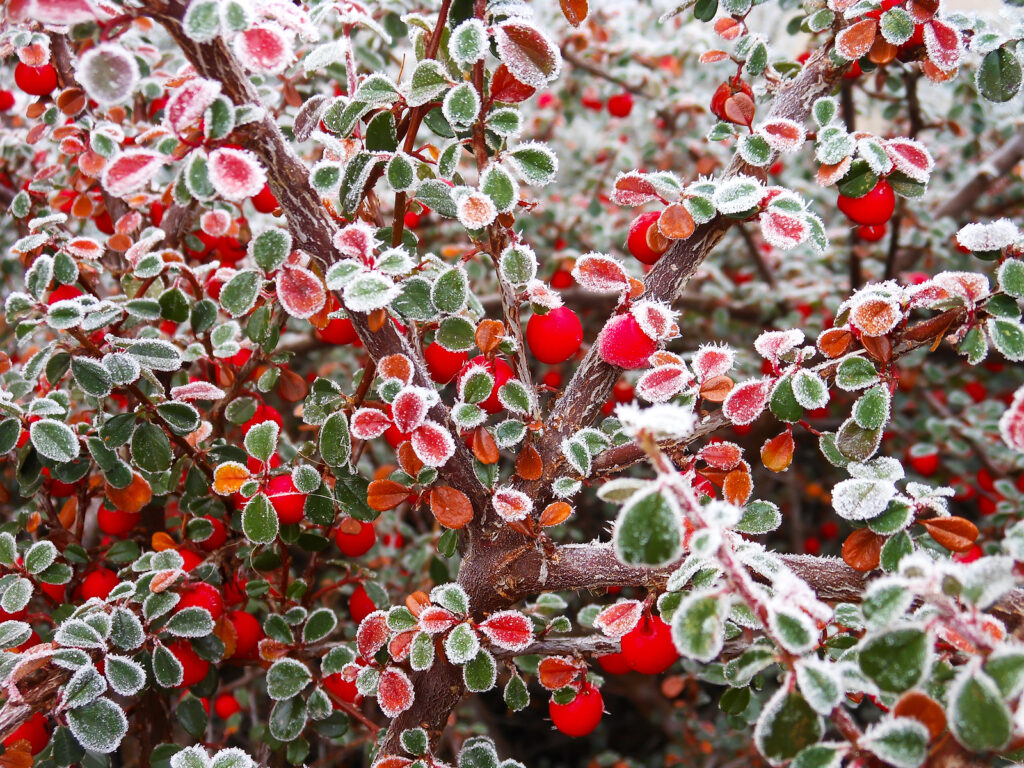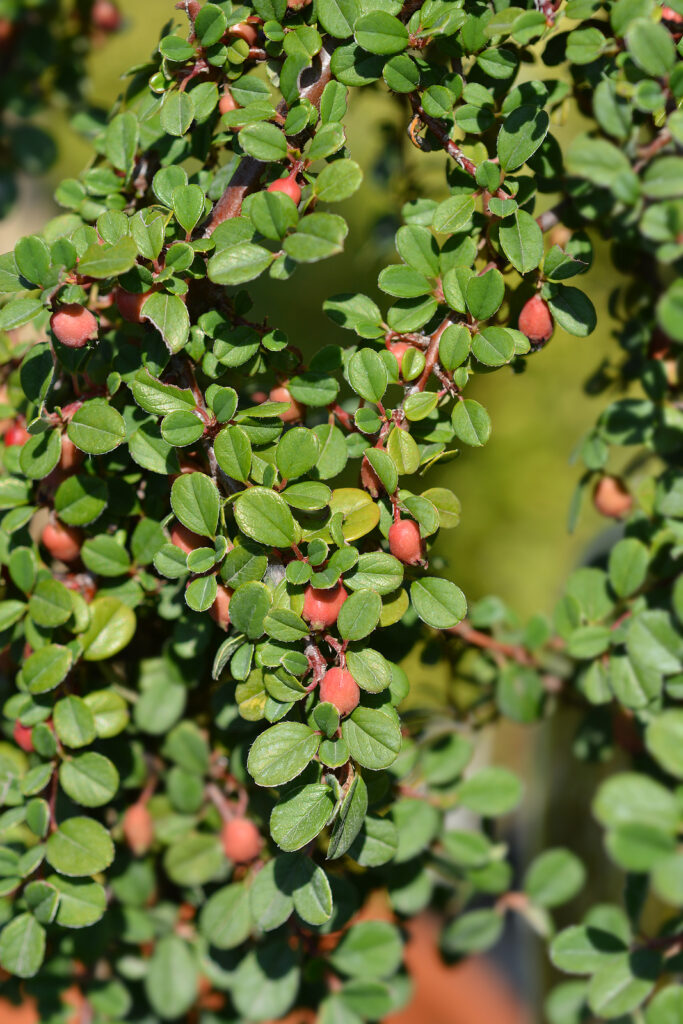Cotoneaster is a genus of evergreen, semi-evergreen, and deciduous shrubs; Low-growing types can be used as groundcovers; medium to tall types can be used as hedges and screens. Most have graceful, arching branches, small white flowers in mid to late spring, and red berries that hold on the plant from late summer into winter.
All Cotoneasters are vigorous growers and thrive with little or no attention. Cotoneaster can tolerate poor soil and drought.
Cotoneasters tend to look best when allowed to maintain their natural fountain shape. Tall growing varieties can be sheared, but pruning simply to enhance the plant’s graceful arch of branches and to remove old wood is all that is needed.
There are more than 200 species of Cotoneaster. Species include deciduous, semi-evergreen, and evergreen shrubs and trees from temperate regions of Europe, Asia, and North Africa.

Get to know Cotoneaster
- Plant type: Evergreen, semi-evergreen, and deciduous shrubs
- Growing zones and range: Zones 4 to 9 depending on the variety
- Hardiness: Hardy to Zone 6 in most varieties
- Height and width: 1 foot to 18 feet tall and wide depending on the variety; there are groundcover cotoneasters as well as tall shrub varieties (see selected varieties below).
- Growth rate: Slow to medium.
- Form and habit: Tiered mound; usually a charming sprawl
- Foliage: Flat, .2-.5 inches (.5-1.3cm) long, not quite as wide, lustrous dark green above; foliage is finely textured.
- Flowers: Dainty pink or white flowers in spring; the flowers are often inconspicuous.
- Fruits: Spherical bright red fruit .3 inch (.8cm) diameter follows flowers.
- Bloom time: Mid to late spring
- Uses: Ground cover, screening, massing, espalier, edge rock walls, draping down the sides of raised beds, trained against walls, or used in borders or as hedges.
- Common name: Cotoneaster
- Botanical name: Cotoneaster
- Family name: Rosaceae
- Origin: Europe, Asia, and North Africa.
Where to plant Cotoneaster
- Plant Cotoneaster in full sun to high shade by or under tall trees.
- Evergreen Cotoneaster will tolerate shade but will not fruit as heavily.
- Plant Cotoneaster in well-drained sandy soil or clay; pH 6.0-7.0.
- Cotoneaster does not tolerate wet feet.
- Most Cotoneaster can withstand wind and drought.
- Cotoneaster tolerates salt when established.

When to plant Cotoneaster
- Container-grown Cotoneaster can be transplanted easily in spring or autumn to a sunny site and almost any soil that is moist and well-drained, acid or alkaline.
- Give flat-growing Cotoneaster room to spread; avoid planting near a walk or drive where branch ends will need frequent cutting back.
Planting and spacing Cotoneaster
- Space Cotoneaster according to the spread of the variety you are planting, usually not closer than 10 feet (3m) apart.
- To grow Cotoneaster against a wall, secure a few widely separated main branches on the surface and allow them to develop their side branchlets.
How to water and feed Cotoneaster
- Give Cotoneaster moderate water.
- Cotoneaster needs moisture but can handle drought once established.
- Feed Cotoneaster with an all-purpose organic fertilizer in spring.

How to prune and care for Cotoneaster
- Cotoneaster needs minimal pruning, best undertaken when the berry display is over.
- Keep an informal Cotoneaster hedge in bounds with light and selective pruning during the growing season.
- Lightly shear a formal Cotoneaster hedge as needed.
- Although some medium and tall growing Cotoneaster can be sheared, they look best when allowed to maintain natural fountain shapes. Prune only to enhance the graceful arch of branches.
- Keep medium growing Cotoneaster looking young by pruning out a portion of oldest wood each year.
- Prune Cotoneaster ground cover by removing dead or awkward branches.
Cotoneaster pests and diseases
- Cotoneaster is susceptible to rust, powdery mildew, stem cankers, and fire blight.
- Cotoneaster can be attacked by scale insects, rose slugs, spider mites, slugs, and snails.
Cotoneaster propagation
- Cotoneaster can be propagated by hormone-treated softwood cuttings in early summer.
- Sow seed in containers in a cold frame as soon as they are ripe, usually in autumn.
- Root semi-ripe cuttings of evergreen and semi-evergreen species in late summer.
- Root greenwood cuttings of deciduous species in early summer.

Cotoneaster varieties to grow
- Cotoneaster adpressus, Creeping Cotoneaster, a deciduous, compact species with a stiff habit, reaches 1-1.5 feet (.3-.5m) high, spreading 6 feet (1.8m). The leaves have wavy margins and turn red in fall. The white flowers are tipped with pink and are followed by small red fruits. This species is especially tolerant of a wide range of pH and adapts to seaside conditions, although it is prone to spider mites where the weather is hot and dry. Zones 5 to 8.
- C. apiculatus, Cranberry Cotoneaster, deciduous, low, and spreading shrub to 3 feet (.9m) high and 8 feet (2.4m) wide, similar to C. adpressus. Alternate glossy .5 inch (1.3cm) leaves turn red or bronze-purple in fall. Solitary white flowers are followed by round red .3 inch (.8cm) fruits, which it holds in winter. Zones 4 to 7.
- C. dammeri, Bearberry Cotoneaster, evergreen, makes a tiered mound 1-1.5 feet (.3-.5m) high and spreads 6 feet (1.8m) or wider. Makes a fast-growing ground cover for banks, rocky soil, and other difficult conditions, but after several years it needs pruning to keep it from looking ragged. The fruits, which can be unreliable, look like tiny apples. Cultivars have been selected for vigor, better fruiting, and greater or lower height. Zones 5 to 8.
- C. divaricatus, Spreading Cotoneaster, a fast-growing pink-flowered shrub 6-8 feet (1.8-2.4m) tall with a wider spread, has glowing reddish-purple foliage. Erect, rounded, deciduous shrub. The 1-inch (2.5cm) long, .5 inch (1.3cm) wide leaves are especially dark and glossy, turning orange to red in fall, setting off the egg-shaped, dark red, .3 inch (.8cm) berries. It is less pest-prone than other cotoneasters. Zones 4 to 7.
- C. horizontalis, Rockspray Cotoneaster, midsize broad upright semievergreen that grows into a tiered mound 3-5 feet (.9-1.5m) high. It bears light pink flowers and masses of red fruits. In fall the leaves turn scarlet-orange and last into winter. The leaves of a variegated cultivar ‘Variegatus’, turn rosy red in autumn.
- C. lacteus, evergreen, graceful, arching habit to 8 feet (2.4m) or taller; clustered white flowers with a heavy crop of long-lasting red berries; best as informal hedge or screen; can be clipped as a formal hedge; can become invasive in mild-winter regions if not tended to.
- C. lucidus, 6-10 feet (1.8-3.1m) hedge cotoneaster, hardy in Zones 6-8, bears pinkish flowers and sports red-to-yellow foliage in fall.
- C. microphyllus, rockspray cotoneaster: evergreen with horizontal branches that rail and root to 6 feet long; very small dark green leaves are gray beneath; effective in rock gardens, on banks.
- C. procumbens, also listed as C. dammeri.
- C. salicifolius, willow-leaf cotoneaster, evergreen or semi-evergreen erect, spreading shrubs grows 10-15 feet (3.1-4.57m) tall; narrow dark green leave and bright red fruit; graceful screening or background plant but can self-sow and become invasive if not controlled; ‘Emerald Carpet’ is a trailing form to 8 feet wide; hardy in Zones 6 to 8.















